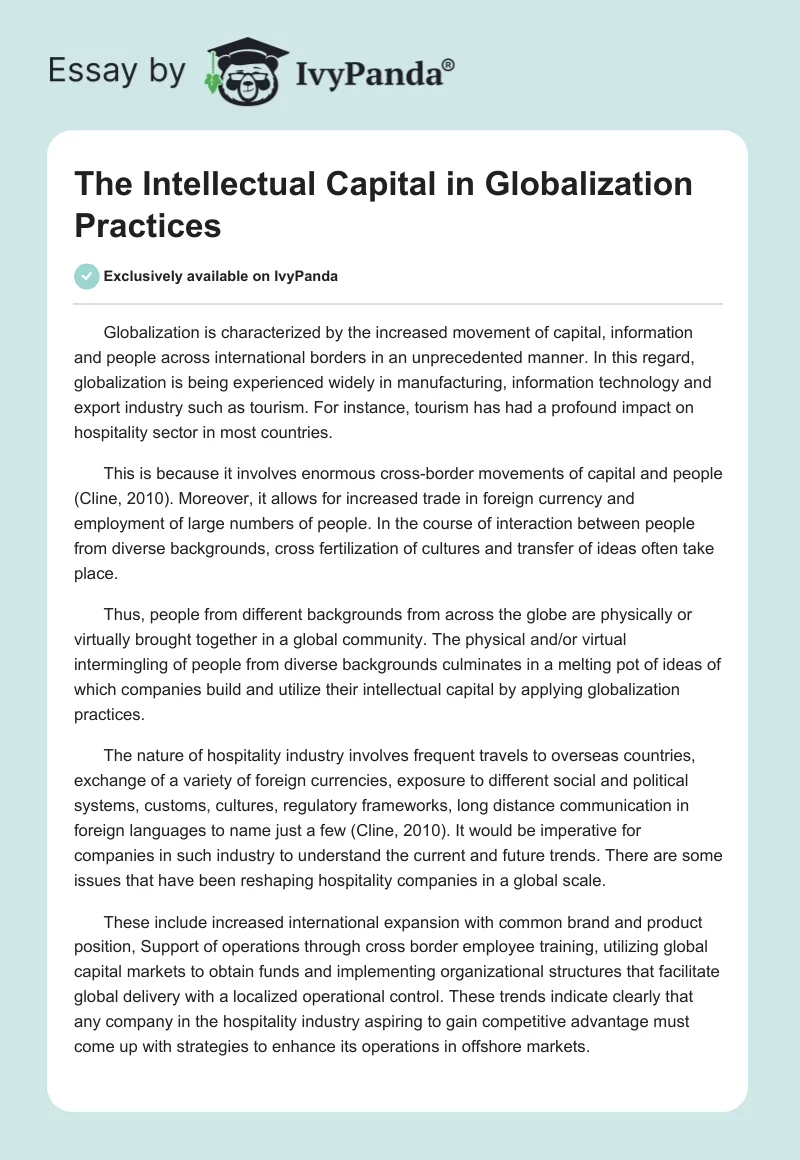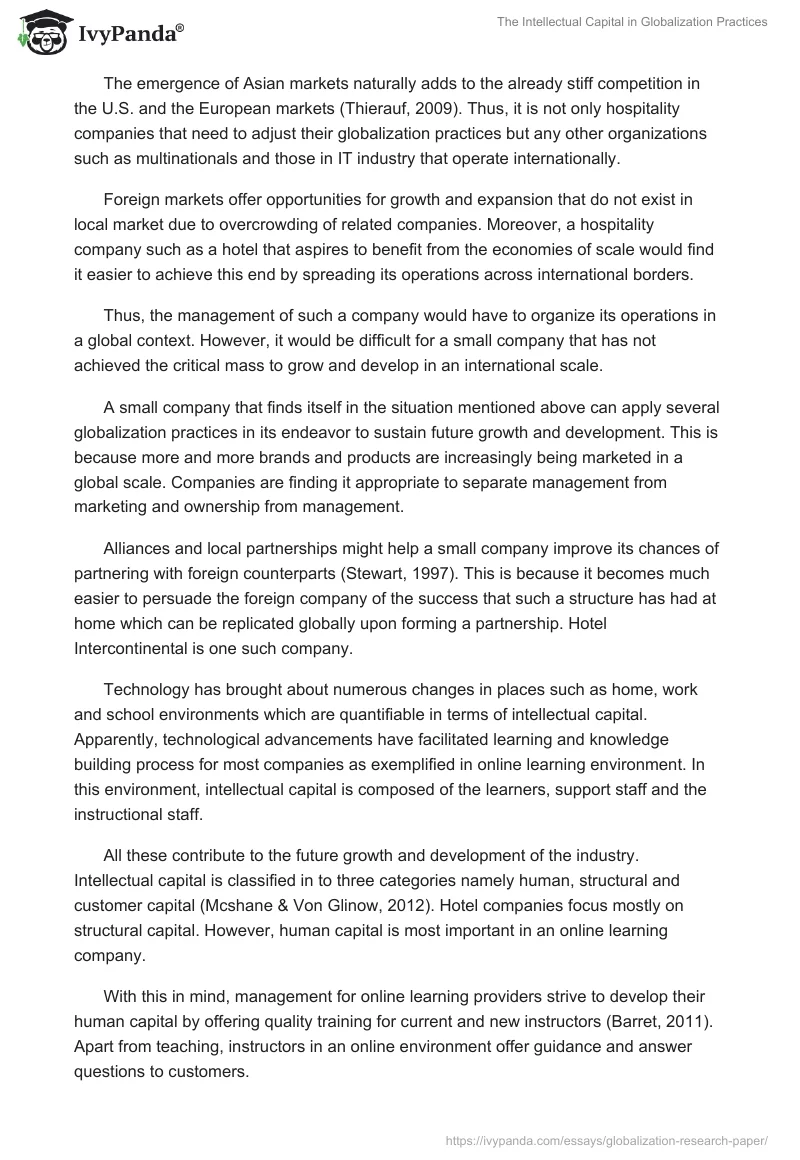Globalization is characterized by the increased movement of capital, information and people across international borders in an unprecedented manner. In this regard, globalization is being experienced widely in manufacturing, information technology and export industry such as tourism. For instance, tourism has had a profound impact on hospitality sector in most countries.
This is because it involves enormous cross-border movements of capital and people (Cline, 2010). Moreover, it allows for increased trade in foreign currency and employment of large numbers of people. In the course of interaction between people from diverse backgrounds, cross fertilization of cultures and transfer of ideas often take place.
Thus, people from different backgrounds from across the globe are physically or virtually brought together in a global community. The physical and/or virtual intermingling of people from diverse backgrounds culminates in a melting pot of ideas of which companies build and utilize their intellectual capital by applying globalization practices.
The nature of hospitality industry involves frequent travels to overseas countries, exchange of a variety of foreign currencies, exposure to different social and political systems, customs, cultures, regulatory frameworks, long distance communication in foreign languages to name just a few (Cline, 2010). It would be imperative for companies in such industry to understand the current and future trends. There are some issues that have been reshaping hospitality companies in a global scale.
These include increased international expansion with common brand and product position, Support of operations through cross border employee training, utilizing global capital markets to obtain funds and implementing organizational structures that facilitate global delivery with a localized operational control. These trends indicate clearly that any company in the hospitality industry aspiring to gain competitive advantage must come up with strategies to enhance its operations in offshore markets.
The emergence of Asian markets naturally adds to the already stiff competition in the U.S. and the European markets (Thierauf, 2009). Thus, it is not only hospitality companies that need to adjust their globalization practices but any other organizations such as multinationals and those in IT industry that operate internationally.
Foreign markets offer opportunities for growth and expansion that do not exist in local market due to overcrowding of related companies. Moreover, a hospitality company such as a hotel that aspires to benefit from the economies of scale would find it easier to achieve this end by spreading its operations across international borders.
Thus, the management of such a company would have to organize its operations in a global context. However, it would be difficult for a small company that has not achieved the critical mass to grow and develop in an international scale.
A small company that finds itself in the situation mentioned above can apply several globalization practices in its endeavor to sustain future growth and development. This is because more and more brands and products are increasingly being marketed in a global scale. Companies are finding it appropriate to separate management from marketing and ownership from management.
Alliances and local partnerships might help a small company improve its chances of partnering with foreign counterparts (Stewart, 1997). This is because it becomes much easier to persuade the foreign company of the success that such a structure has had at home which can be replicated globally upon forming a partnership. Hotel Intercontinental is one such company.
Technology has brought about numerous changes in places such as home, work and school environments which are quantifiable in terms of intellectual capital. Apparently, technological advancements have facilitated learning and knowledge building process for most companies as exemplified in online learning environment. In this environment, intellectual capital is composed of the learners, support staff and the instructional staff.
All these contribute to the future growth and development of the industry. Intellectual capital is classified in to three categories namely human, structural and customer capital (Mcshane & Von Glinow, 2012). Hotel companies focus mostly on structural capital. However, human capital is most important in an online learning company.
With this in mind, management for online learning providers strive to develop their human capital by offering quality training for current and new instructors (Barret, 2011). Apart from teaching, instructors in an online environment offer guidance and answer questions to customers.
Technological advancements have led to the evolution of distance learning into online (virtual) learning environments (Montano, 2005). The spread of technology across the globe has led to the emergence of a new type of student population. This population differs from traditional learning environment in that it consists of more women, older people, disabled people and people from all walks of life.
Such demographical changes in student population have led to the formation of an online community that whose learning needs can no longer bet met through traditional learning methods. Thus, there are certain adjustments that instructors ought to make in their course offerings and teaching styles. This is for the sake of accommodating students from diverse cultural backgrounds in the virtual environment. Technology has provided the requisite infrastructure to help bring together the business world and online learning institutions.
The benefits of online learning are attracting the attention of more and more people from around the world. In this regard, companies have undertaken the initiative of investing in their intellectual capital by taking advantage of the virtual learning environment. To facilitate the movement of a company towards global expansion and ventures, global branding of its goods and services is necessary.
The quality and acceptance of a companies brand will depend on how well the cultural differences of the target market are reflected. The virtual learning communities have inevitably created a new type of global branding of education by bringing together people from diverse backgrounds across the world (Daniel, et.al, 2003). Companies in the online learning industry are utilizing a global brand of management information systems to cater for the needs of the students in the online learning communities.
The online communities’ help individuals learn and grow from each others experiences. When this is coupled with technology, knowledge is created within an individuals group and in the organization thus improving company’s goals (Mann, 2008). The knowledge revolution that took place at the turn of the century has seen people shift focus from traditional economic assets such as labor, capital and land into intangible assets such as knowledge.
Microsoft is a knowledge based company that focuses more on intangible assets (Mann, 2008). Most of the profits made by the company come from intangible assets. The company uses an extensive network of contracts that are both formal and informal and that include firms such as Sony, Intel to name just a few (Edvinsson & Malone, 2007). Innovation in Microsoft is facilitated by human mind which acquires knowledge through learning.
Data from the Federal Reserve indicates that U.S. based investors are increasingly investing in intangible assets. These assets include, intellectual capital of databases, methods of doing business, patents to name just a few. The value of intellectual capital as at 2011 is estimated to be $ 14.5 trillion (Barret, 2011). This is an indicator that the world is moving towards an idea based economy since investors are investing less in physical assets and more in intangible assets.
Organizational and technological innovations have been at the forefront in adding value to intangible assets and intellectual property. Companies operating in global markets make profits depending on the level of quality of their intellectual capital. With rapid globalization, competition in the area of intellectual capital goes up (Stewart, 1997). This is because advanced technology reduces the time a company has to market its innovation prior to entry of competitors.
In the contemporary world, borders no longer restrain international trade courtesy of advances in technology. More businesses have resorted to outsourcing with a bid of lowering costs for doing business (Merryfield, 2003). Outsourcing helps companies maximize revenues by providing them with a cheap source of labor. As companies venture into the global economy, it becomes imperative for them to seek for financing from global capital markets.
According to Cline (2010) the revolution in communications has placed financial markets at the focal point of globalization. Hence, hospitality products, intangible assets such as R & D and virtual products will be traded as commodities in securities markets in the near future. Any company aspiring to sustain profitability must ensure that its products are homogeneous like in the case of Coca cola.
References
Barret, B. (2011). Developing and implementing strategies to Enhance Intellectual Capital in the Online Learning Environment. Academic Publishing International, 5(7)211-218.
Cline, R. (2010) Hospitality Adjusts To Globalization. Ideas and Trends, 11(13), 12-14.
Daniel, B., Schwier, R., & McCalla, G. (2003). Social capital in virtual learning communities and distributed communities of practice. Canadian Journal of Learning and Technology, 29(3), 113-139.
Edvinsson, L. & Malone, M. (2007). Intellectual capital: realizing your company’s true value by finding its hidden brainpower. New York, NY: Harper Collins.
Mann, L. (2008). Globalization of I.T. Services and White Collar Jobs. International Economics policy briefs, 3(2), 891-903.
Merryfield, M. (2003). Like a veil: Cross-cultural experiential learning online. Contemporary Issues in Technology and Teacher Education, 3(2), 146-171.
McShane, S. & Von Glinow M. (2012). Organizational Behavior (6th ed.) New York, NY: McGraw Hill/Irwin.
Montano, B. (2005). Innovations of Knowledge Management. Upper Saddle River, NJ: Pearson Prentice Hall.
Stewart, T. A. (1997) Intellectual Capital: The new wealth of organizations. New York, NY: Currency Doubleday.
Thierauf, R. (2009). Knowledge Management Systems for Business. Ardsley NY: Transnational Publishers.


